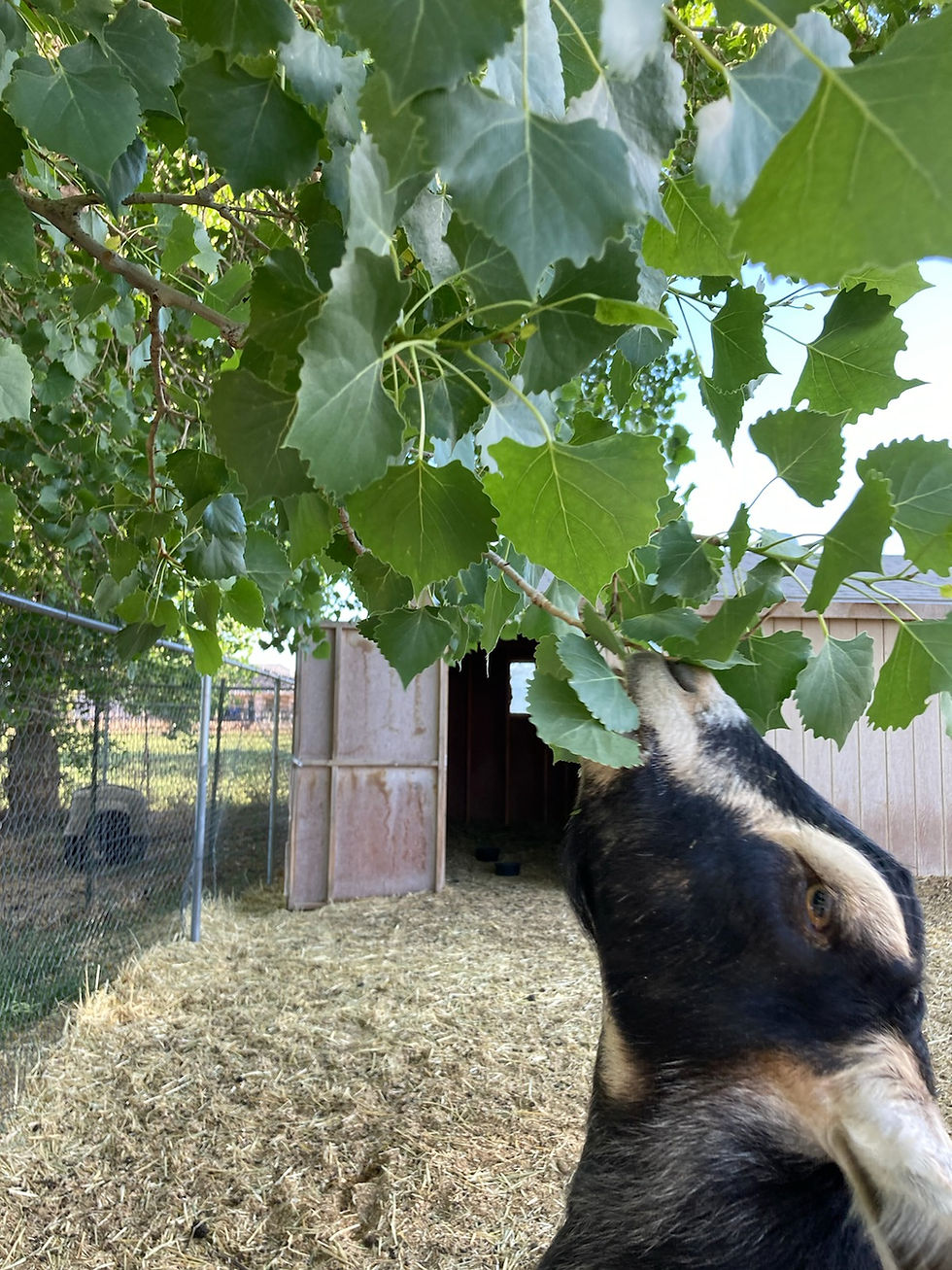Shade Cloths and Figs
- Margaret James

- May 28, 2021
- 3 min read
Here’s another photo from my photography class:

It’s Polly in the foreground, with Ocean behind her. (And parts of other goats). I like how our goats are curious about whatever we’re doing.
Speaking of curious, we put up two new shade cloths this week. One was in the milkers’ pen - a replacement for a shade cloth that finally split down the middle one extremely windy day. The other was in the pen where Leroy, Sam, and Wendell live.

Those three goats had had two poplar trees for their shade, but one of the poplar trees died, and the other is dying. Until our poplars were dying, I never thought about the life span of trees. There are huge differences between various types. The location of the trees can also influence their longevity.
The typical urban street tree lives between 19 and 28 years (according to the USDA). Bristlecone Pines, Yews, and Ginko Bilobas - not in urban areas - can live for thousands of years. There’s a Bristlecone Pine in California, and one in Colorado, that are each about 5,000 years old.
A typical Lombardy Poplar, however, usually dies within 15 years. They are the rock stars of trees - growing fast and dying young. In fact, generally, the faster growing trees die younger than the slower growing ones.
The Bodhi Tree, in Bodh Gaya, India, is the tree that the Buddha was sitting underneath when he attained enlightenment. You can go visit the tree. It is supposedly 2,500 years old. Of course, many people think this is not the exact tree, but rather a descendant of the Buddha’s tree. In any case, it is a fig tree.

Figs are part of the mulberry family. Fig trees were one of the first fruit trees to be cultivated. There are 750 different varieties of fig trees, and they are important in nearly every ancient world religion. Both Indonesia and Barbados have images of a fig tree on their coat of arms. The Egyptian Pharoahs were buried with dried figs - to sustain them on their journey to the afterlife, where the goddess Hathor would emerge from a fig tree to welcome them.
Figs may have been so important because, in addition to being tasty, they are loaded with vitamins and minerals. So, eat those Fig Newtons without guilt.
In the evolution of plants growing on land (as opposed to where they began - in water) moss came first. That was hundreds of millions of years ago. Moss was followed by ferns, then by ginkos. Who knew ginkos were such ancient trees? Like opossums and coelacanths, ginkos are living fossils - links to the age of dinosaurs. Ginkos are unique in that they are a single species with no living relatives. Ginkos have not changed in 200 million years.
Anyway, conifers came next - about 245 million years ago - and finally we got flowering trees. (A follow-up from last week: roses came into being about 37 million years ago. Alexander the Great is credited with bringing roses to Europe).
But, we should return to our shade cloth - which will provide cool comfortable afternoons for our goats now that our poplars are failing. They enjoyed watching us install it, and they’ve spent every afternoon since lounging underneath.
Look at these eggs:

See the tiny one? What’s up with that? Our hens are all past the stage of laying fairy eggs (although I cracked this one open, and indeed, there was no yolk). Jan speculated that possibly one of our broody hens laid this. Hens don’t lay eggs while they’re broody. They just sit on the pile of eggs, while other chickens come into the nesting box, lay eggs, and shove them underneath the broody hen. Chicken society is crazy, if you ask me.
One of my favorite things about summer is watching the goats stand up and chew on tree leaves.

This is Molly (Mothra’s daughter). I had pulled the hay cart into the back pen. She stood up with her front hooves on the cart in order to reach the leaves.

When we have wind storms that bring down branches we throw the branches into the pens because the goats love chewing on the fresh leaves.
This week two more of our new soaps ripened and we added them to our website for sale. The first one, Autumn Wind, is Kat’s design, and my favorite bar so far:

The second is also beautiful - and lilac scented:

I’m excited about selling these bars. I love that they’re the same gentle formula as our original bars. I love that the images will last through the entire bar - in some cases morphing slightly as the swirls gradually take on different shapes.
In any case, you can order your own tiny works of art in soap here: https://www.serenasoaps.com/. Go to the Picture Bars section and browse!




Was it on Good Friday that the cloth split down the middle?